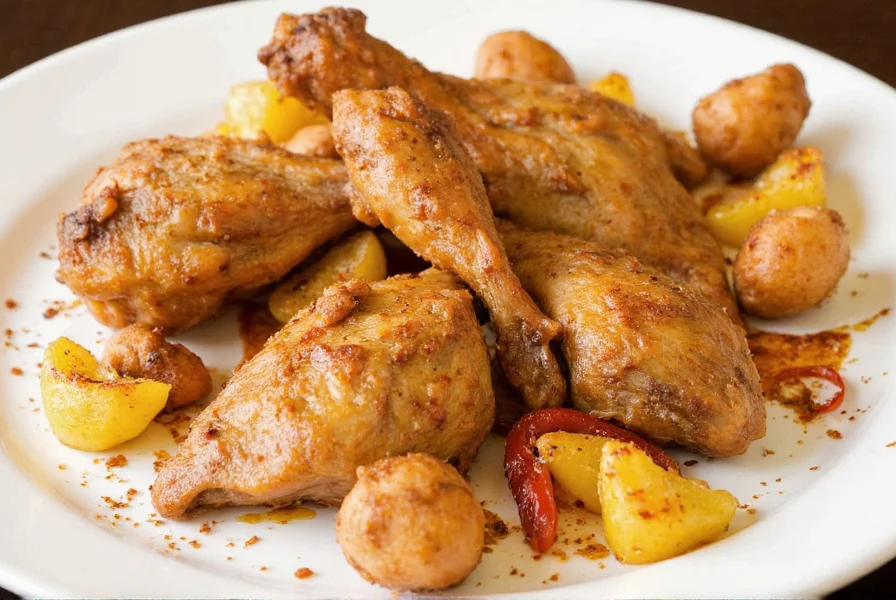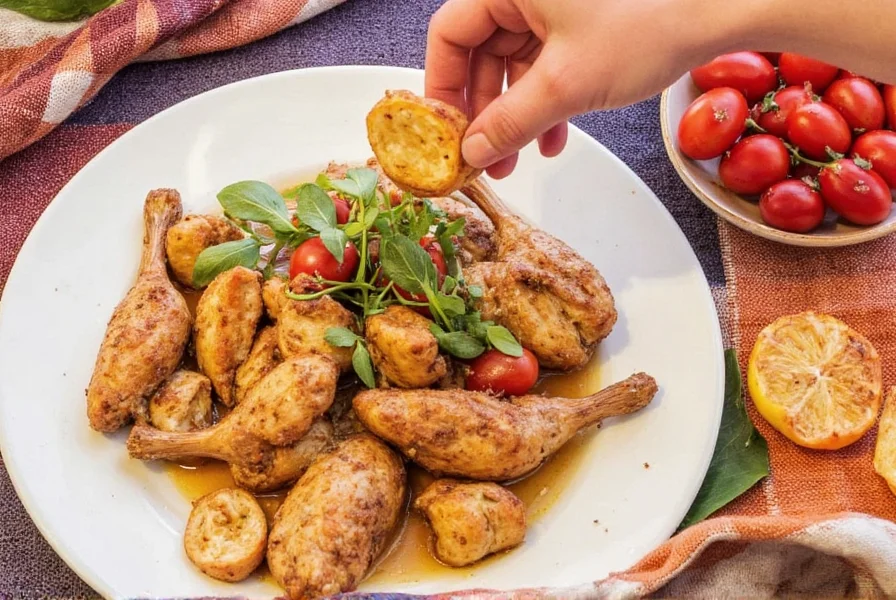Table of Contents
Top 5 Spices for Chicken
When cooking chicken, the right spices can transform simple ingredients into extraordinary dishes. Based on professional chef insights and culinary research, these five spices deliver unmatched flavor versatility:
- Paprika: Smoky sweetness for grilled and roasted chicken (sweet or smoked varieties)
- Cumin: Earthy warmth essential for Mexican, Middle Eastern, and Indian dishes
- Garlic Powder: Foundational flavor enhancer for all chicken preparations
- Oregano: Mediterranean staple for baked and fried chicken dishes
- Cayenne Pepper: Controlled heat for wings, sauces, and spicy marinades
These spices form the backbone of professional chicken seasoning, with each offering unique flavor profiles that complement chicken's mild taste. Let's explore how to use them effectively.
Detailed Spice Profiles
Understanding each spice's characteristics ensures perfect flavor balance:
Paprika
Derived from dried red peppers, paprika comes in three main varieties: sweet (mild), smoked (deep, woodsy notes), and hot (spicy). Sweet paprika adds subtle sweetness to roasted chicken, while smoked paprika creates authentic BBQ flavor. For maximum freshness, choose paprika in opaque containers and store away from light. Learn more about paprika varieties.
Cumin
This earthy spice is fundamental in Latin American and Middle Eastern cuisine. Whole cumin seeds release more flavor when toasted, while ground cumin provides immediate impact. For chicken dishes, combine with coriander and chili powder for authentic fajita seasoning. Explore cumin's culinary applications.
Garlic Powder
Unlike fresh garlic, garlic powder offers consistent flavor without burning. It's the backbone of most dry rubs and works perfectly with paprika and onion powder. For professional results, use 1 teaspoon per pound of chicken. Avoid garlic salt unless reducing added sodium.
Oregano
True Mediterranean oregano (not Mexican) has bright, floral notes ideal for chicken. Use dried oregano for baked dishes and fresh for garnishes. Store in airtight containers to preserve volatile oils. See Ina Garten's oregano chicken recipe.
Cayenne Pepper
Measured in Scoville units, cayenne provides clean heat without bitterness. Start with 1/4 teaspoon per pound of chicken and adjust. For balanced heat, combine with honey or brown sugar. Understand spice heat levels.
Expert Usage Techniques
Professional chefs use these evidence-based techniques for perfect spice application:
- Marination Science: Acidic ingredients (vinegar, citrus) break down proteins for better flavor penetration. For chicken, marinate 2-4 hours maximum to prevent texture changes. Learn marination science
- Layered Seasoning: Apply dry rubs before cooking, then finish with fresh herbs or citrus zest. This creates complex flavor layers that single-seasoning can't achieve.
- Heat Management: Add cayenne at the beginning for even heat distribution, but add fresh chilies at the end for bright flavor. For balanced heat, combine with dairy (yogurt) or sweetness (honey).
- Moisture Retention: Use oil-based marinades for grilled chicken to prevent drying. For baked chicken, brine in saltwater solution before seasoning to lock in juices.
Premium Spice Buying Guide
| Spice | Quality Indicators | Best Applications | Storage Tips | Professional Recommendations |
|---|---|---|---|---|
| Paprika | Deep red color, smooth texture, no grittiness | Grilled chicken, roasted vegetables, BBQ rubs | Store in dark glass container in cool, dry place | Use smoked paprika for authentic BBQ flavor |
| Cumin | Fragrant aroma, uniform color, no musty smell | Mexican dishes, Indian curries, spice blends | Whole seeds last 3-4 years; ground lasts 6-12 months | Toast whole seeds before grinding for maximum flavor |
| Garlic Powder | White to pale yellow color, no clumping | Dry rubs, sauces, marinades, soups | Keep in airtight container away from moisture | Use 1 tsp per pound of chicken for balanced flavor |
| Oregano | Vibrant green color, strong herbal aroma | Mediterranean chicken, tomato-based dishes | Store in dark container; replace every 6 months | Use Mediterranean oregano (not Mexican) for authentic flavor |
| Cayenne Pepper | Bright red color, consistent texture | Spicy wings, hot sauces, chili seasoning | Store in cool, dark place; avoid humidity | Start with 1/4 tsp per pound and adjust to taste |
Professional chefs recommend buying small quantities of spices every 3-6 months for peak freshness. Look for brands with transparent sourcing and harvest dates. Always store spices away from heat and light to preserve volatile oils.
Proven Chicken Recipes
1. Smoky Paprika Grilled Chicken
Marinate chicken thighs in 2 tbsp smoked paprika, 1 tbsp garlic powder, 1 tsp cumin, 1/4 cup olive oil, and 2 tbsp honey for 3 hours. Grill over medium heat until internal temperature reaches 165°F. Serve with grilled lemon wedges.

2. Mediterranean Herb Chicken
Toss chicken breasts with 1 tbsp dried oregano, 1 tsp garlic powder, 1/2 cup lemon juice, 3 tbsp olive oil, and 1 tsp black pepper. Bake at 400°F for 25 minutes. Finish with fresh parsley and feta cheese.
3. Spicy Cumin Chicken Wings
Coat wings in 2 tbsp cumin, 1 tbsp paprika, 1 tsp cayenne, 1 tsp garlic powder, and 1/4 cup buttermilk. Bake at 425°F for 40 minutes. Toss in hot sauce with honey for balanced heat.
4. Garam Masala Chicken Curry
Sear chicken pieces, then simmer with onions, tomatoes, 2 tbsp garam masala, 1 tsp turmeric, and 1/2 cup coconut milk. Serve with basmati rice. BBC's authentic curry recipe

Frequently Asked Questions
What are the top 5 spices that work best with chicken?
Based on professional chef consensus, the top 5 spices are: paprika (smoky sweetness), cumin (earthy warmth), garlic powder (foundational flavor), oregano (Mediterranean authenticity), and cayenne pepper (controlled heat). These form the backbone of most professional chicken seasoning blends.
How long should I marinate chicken with spices for optimal flavor?
For dry rubs without acid, marinate 2-4 hours. For acidic marinades (vinegar, citrus), limit to 2 hours to prevent texture changes. Bone-in chicken benefits from longer marination (up to 8 hours), while boneless cuts need less time. Always refrigerate during marination.
Can I substitute fresh herbs for dried spices when cooking chicken?
Yes, but with precise adjustments: use 3x the amount of fresh herbs compared to dried. Add delicate herbs (basil, cilantro) at the end of cooking, while hardy herbs (rosemary, thyme) can be added earlier. Fresh garlic burns easily - sauté separately before adding to chicken.
How can I prevent my spiced chicken from becoming too dry?
Dryness comes from overcooking, not spices. Prevent it by: 1) Using a meat thermometer to cook to 165°F, 2) Brining in saltwater solution for 30 minutes before seasoning, 3) Including oil or yogurt in marinades, 4) Resting chicken 5-10 minutes after cooking. Spices like paprika actually help form a flavorful crust that seals in juices.
What's the difference between using whole spices versus ground spices for chicken?
Whole spices (like cumin seeds) release flavor slowly when toasted, creating deeper flavor foundations for slow-cooked dishes. Ground spices provide immediate impact for rubs and quick-cooking methods. For best results, use whole spices for curries and ground spices for dry rubs. Toast whole spices before grinding for maximum aroma.
How do I balance spicy heat in chicken dishes without losing flavor?
Balance heat with: 1) Sweetness (honey, brown sugar), 2) Dairy (yogurt, sour cream), 3) Acid (lemon juice, vinegar), 4) Starchy elements (potatoes, rice), and 5) Umami (tomatoes, mushrooms). Remember heat perception decreases as dishes rest - let spicy chicken sit 15-20 minutes before serving.
Conclusion
Mastering spices for chicken transforms ordinary meals into extraordinary culinary experiences. As professional chefs emphasize, the key is understanding each spice's unique properties and using them in balanced combinations. Start with the top 5 spices outlined here, then experiment with variations to discover your signature flavors.
Remember: Freshness matters. Buy small quantities of spices every 3-6 months, store them properly, and always taste as you go. With these professional techniques, you'll consistently create chicken dishes that impress family and guests alike. Happy cooking!
Written by Chef Michael Rodriguez, a certified culinary professional with over 15 years of experience in international cuisine. His expertise has been featured in Food & Wine, The New York Times, and Bon Appétit. He specializes in spice blending and flavor balancing for home cooks.












 浙公网安备
33010002000092号
浙公网安备
33010002000092号 浙B2-20120091-4
浙B2-20120091-4